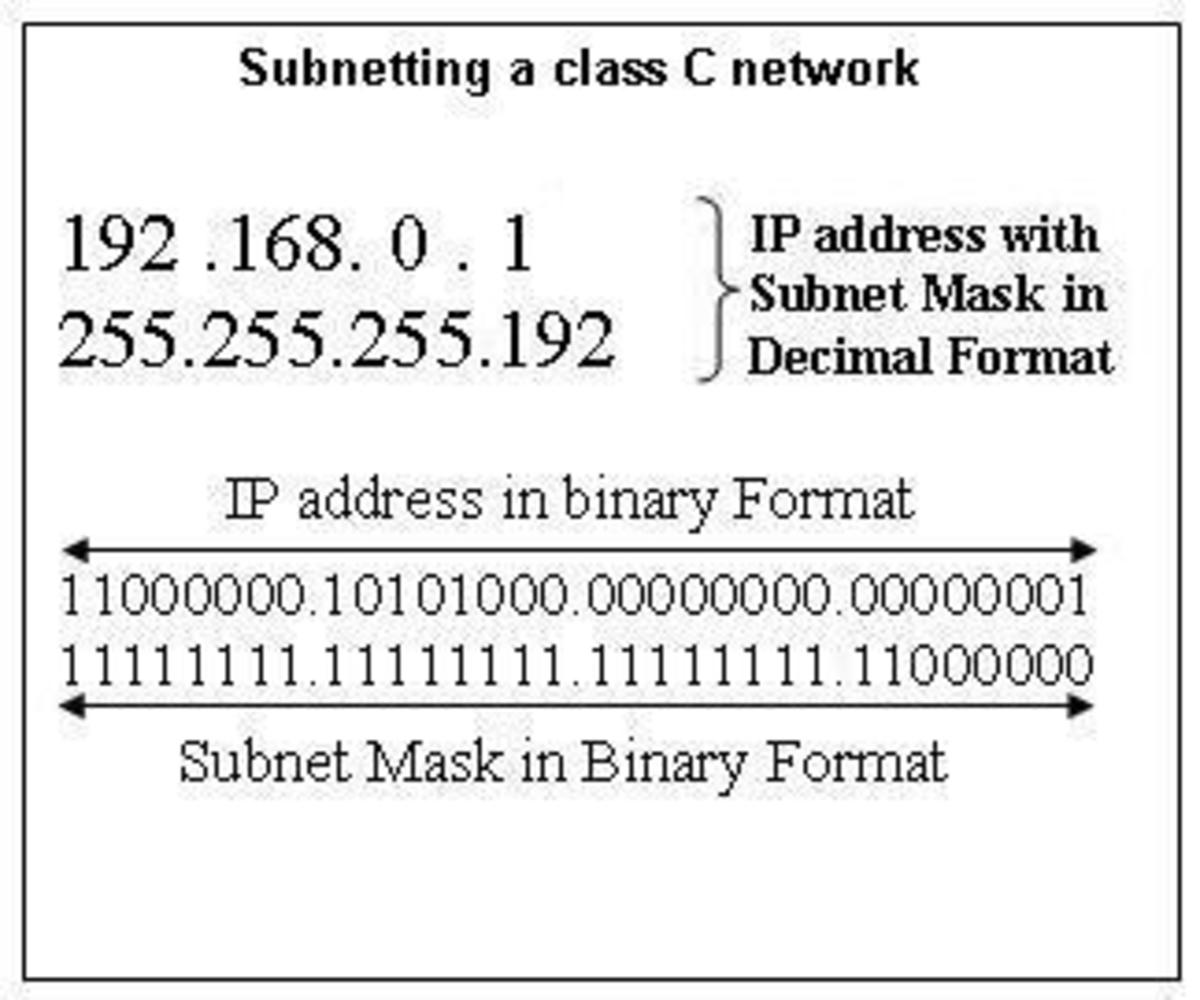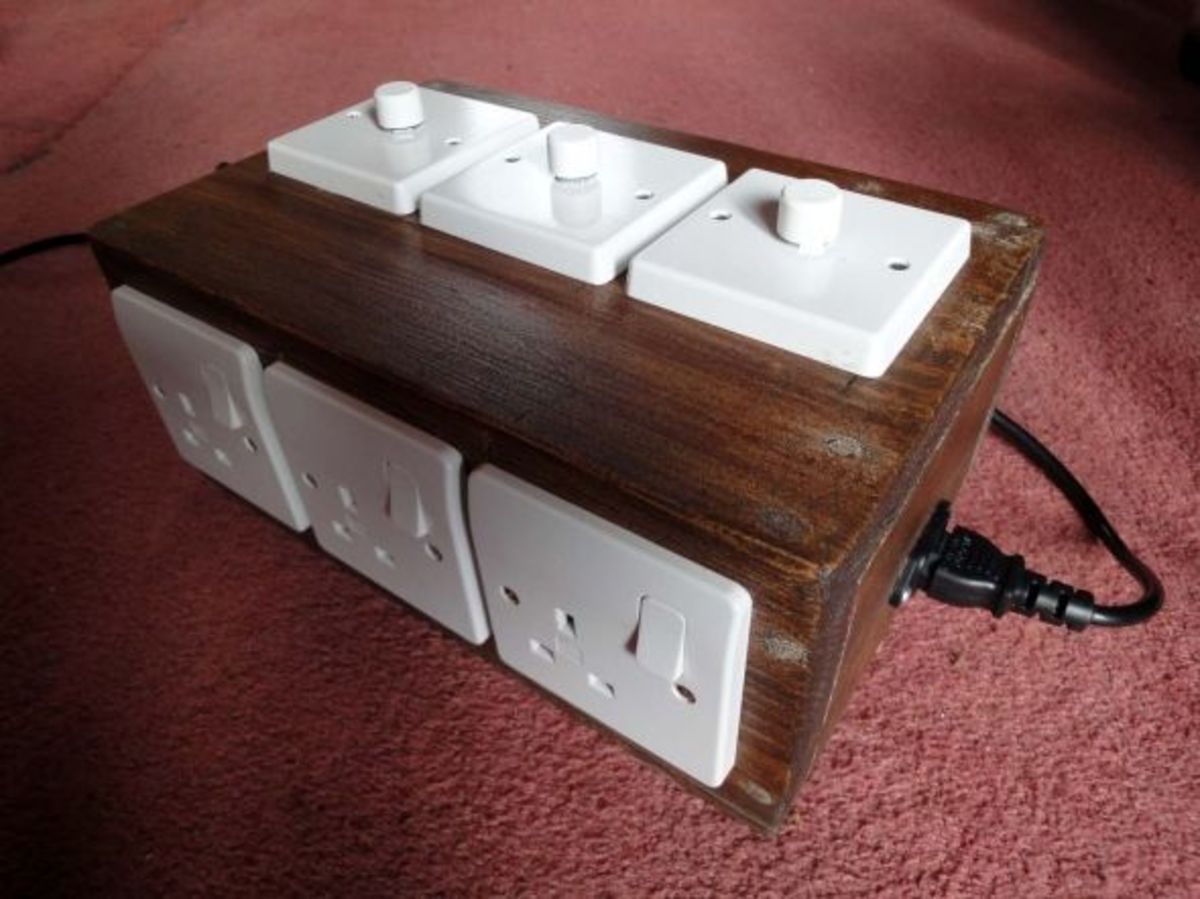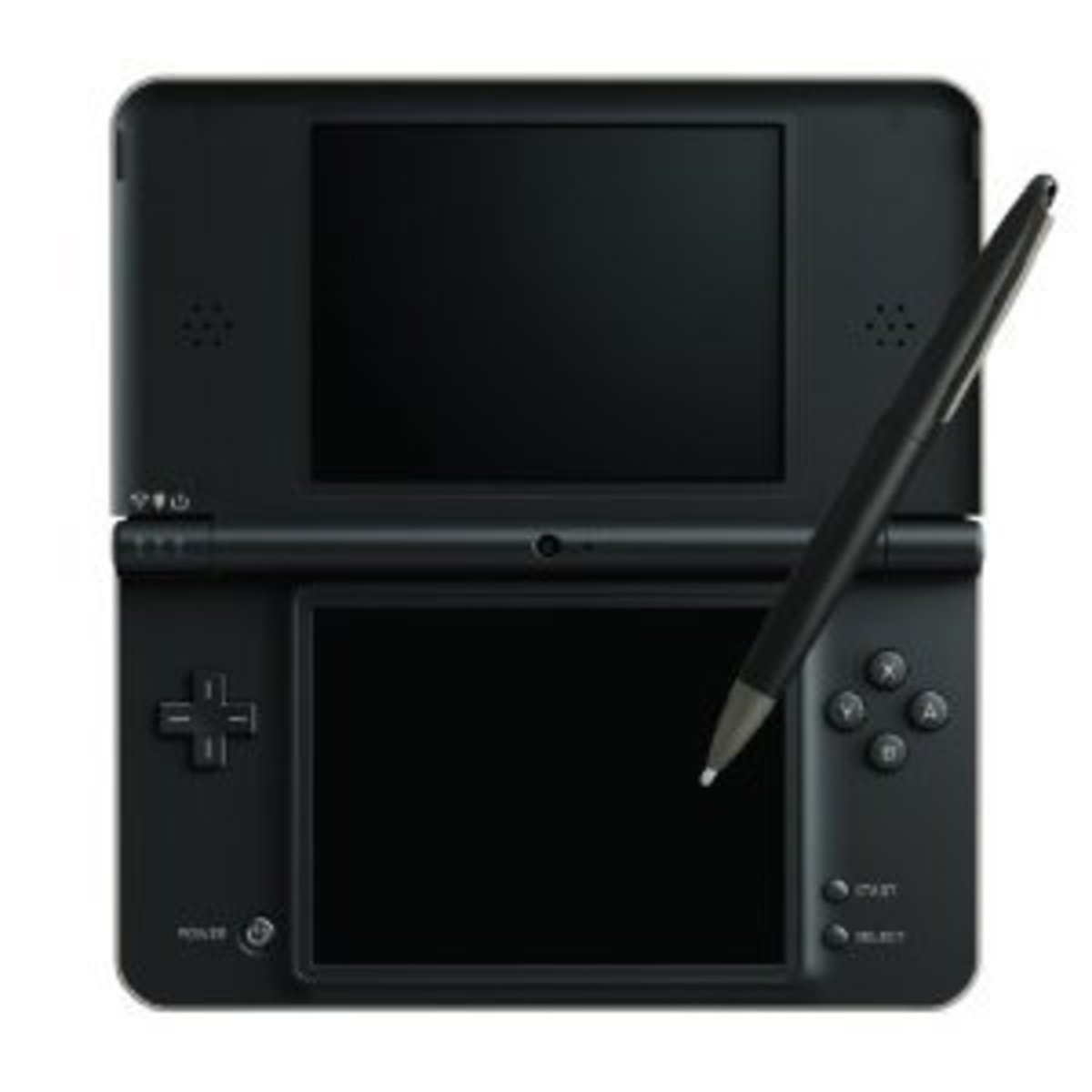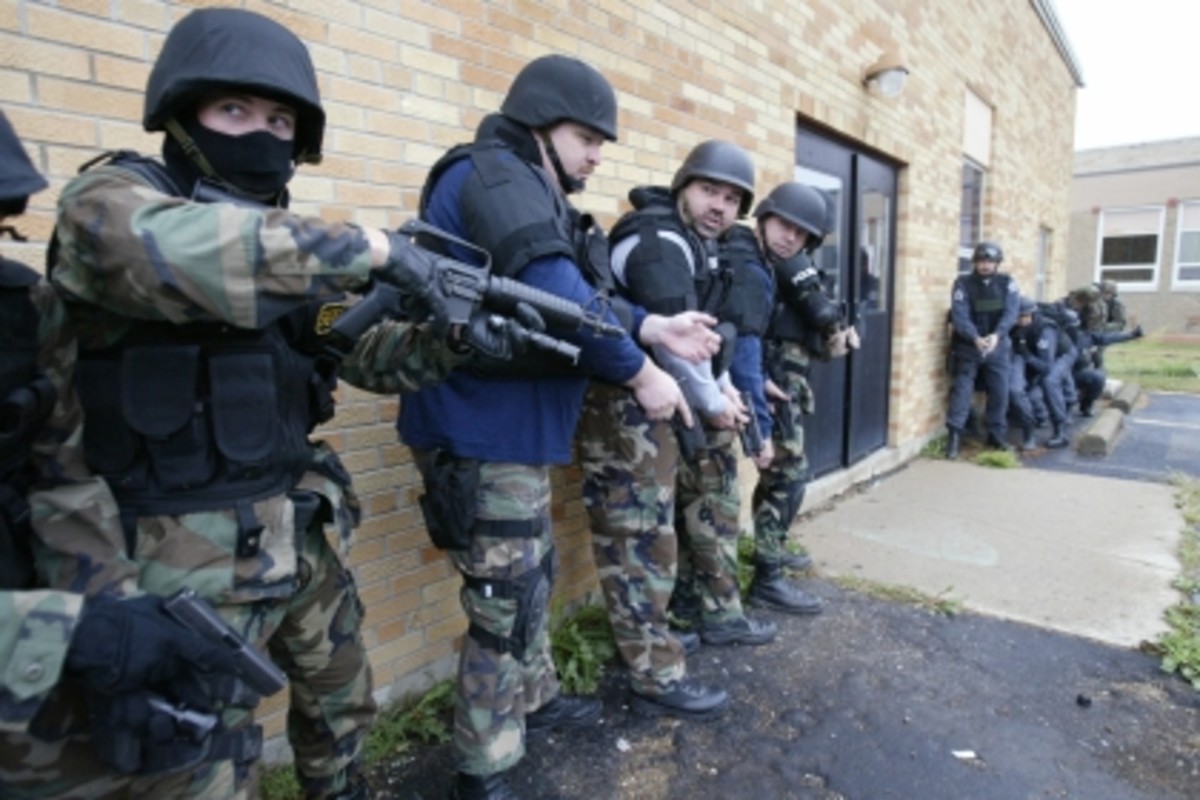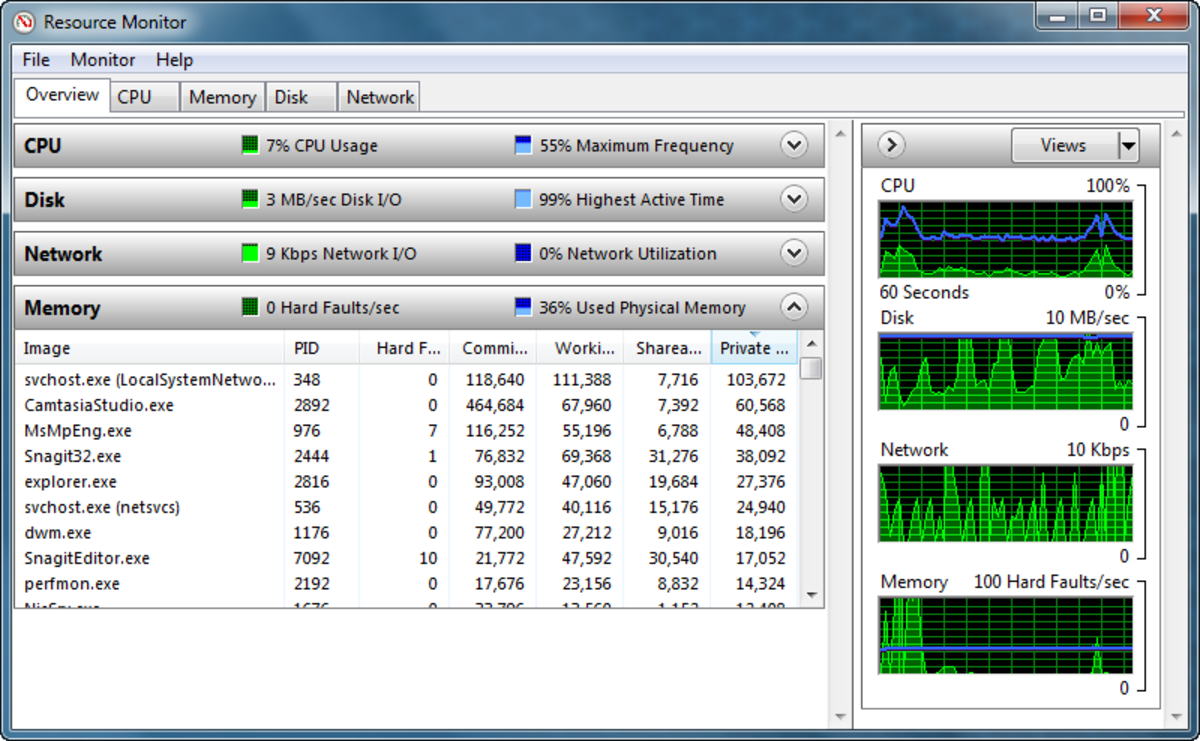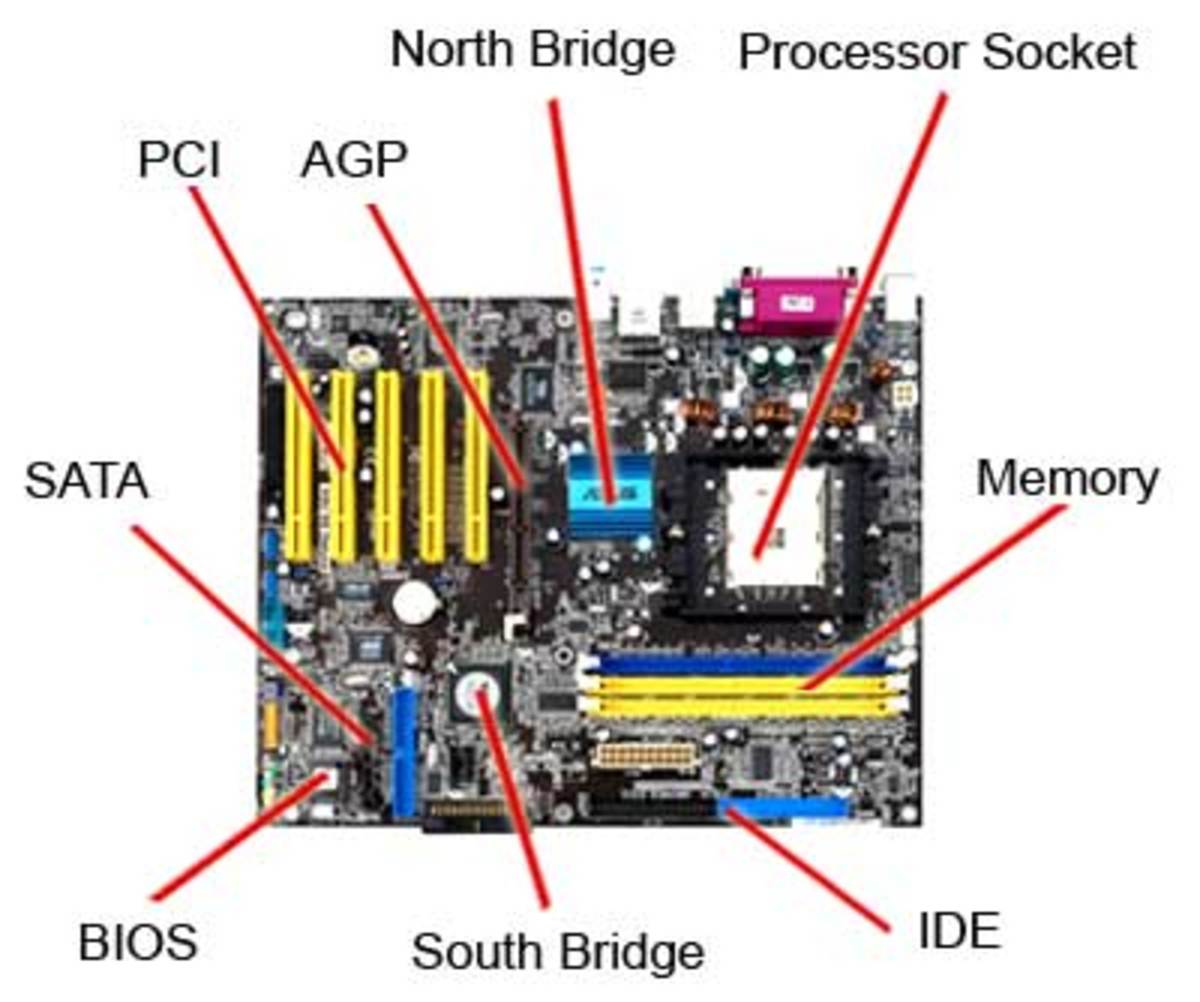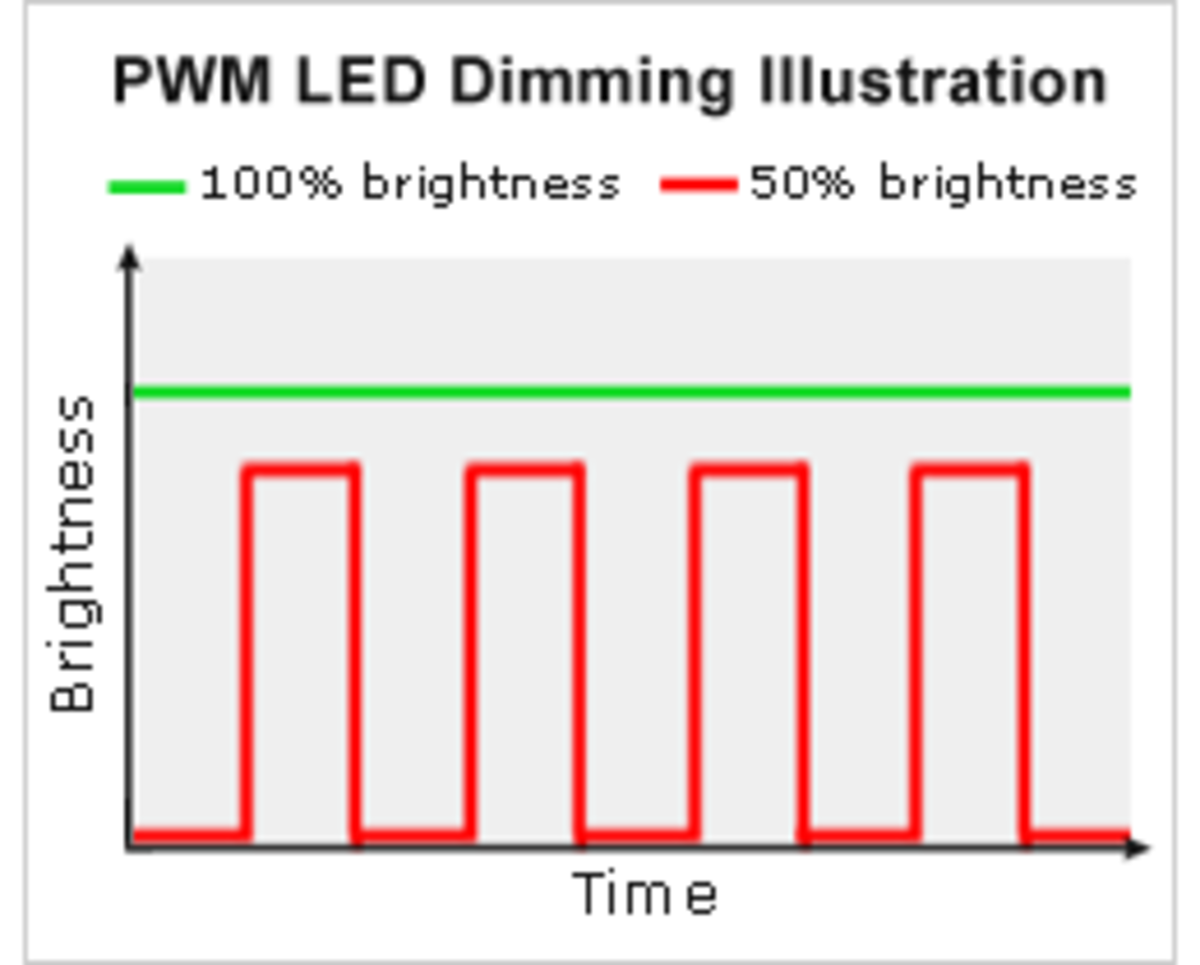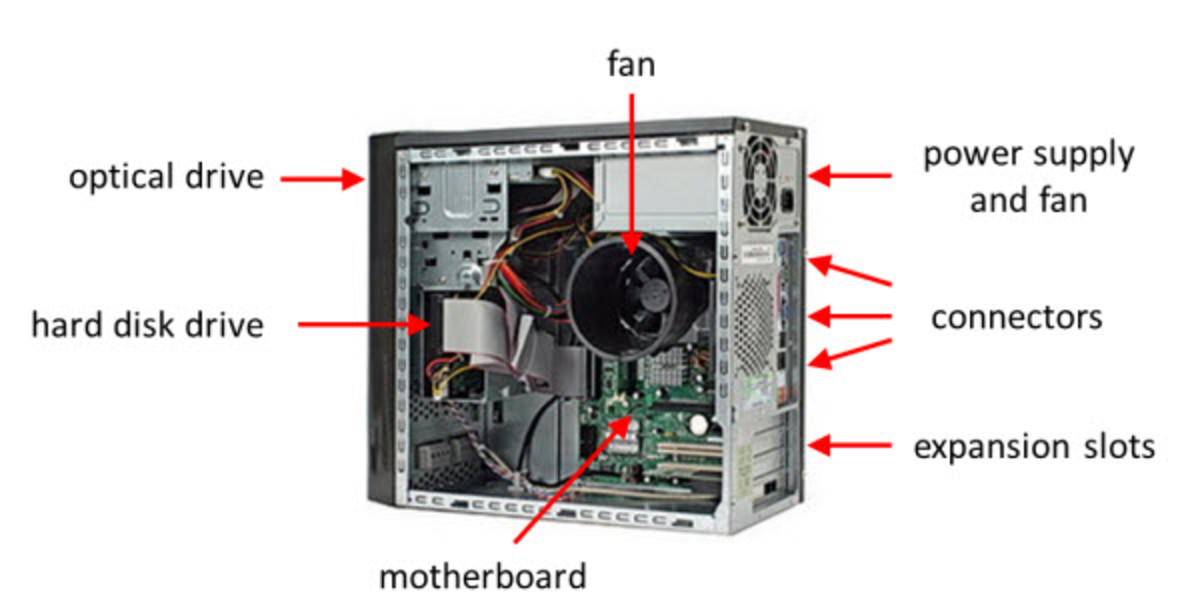GNS3, Cisco, vmWare: Network Labbing and DC Infrastructure
A Genetic Imperative: He who dies with the Most Hardware WINS!
You can do a LOT with a laptop, one small old cheap router (with switch) and GNS3. And, what is the difference between; simulation, and emulation? And how do THEY figure into the training for virtualization?
So, I decided to order some Cisco hardware. Starting with a simple 871w Router, (with built-in switch) and a couple of additional Switches, from eBay- just as anybody else would do trying to train for CISCO networking. I decided on a WS-2950T-24 (it's got 24 10/100 ports and 2x 1000-Base-T GB-ports) I also ordered a WS-C3550-48-EMI 10/100 L3 switch (also with 2x GBIC ports). The 3550 is considered an 'Access Layer' switch in the collapsed-core scheme of things of today's data centers. This early selection of hardware, will be to form the basis of a series of labs for training and experimentation purposes. I do have an "agenda" of sorts, that will reveal itself as time goes on, but. One step at a time.
While I was busy picking and purchasing stuff. I did stumble across a "deal" (which DOES tend to happen on eBay - ) that I did not wish to pass up. I did find a 4908G- L3 switch (with 8 GBIC ports) going at a phenomenally low price, so I snagged THAT as well. That should come in handy later... The 4908 is considered 'Enterprise Backbone-infrastructure' class of hardware. Back in the day it was a hardy beast. It still is (hardy) if not "bleeding edge" tech. It features 8-GBIC ports and can create 2 ether-channels with 4 GigaBit-lines in each channel. Unless you break it into lower bandwidth channels.
And, granted - most of the hardware you will obtain or use, for your own personal training, will likely be "old". It's still useful enough to learn on, and as I can, I will discuss newer trends in hardware, and point out several of the newer changes in hardware, here and there, that you must look forward to, and expect. But do not be fooled, this "old" equipment still operates... it's just no longer operating at the bleeding edge of business any more.
But that's why we ARE learning and remain involved with, all this exciting, and cool technology! To apply it to the new stuff! Just because you are now managing several more virtual switches from one console, does not mean the fundamental operating system is different. It's the SAME STUFF... just a different scale and density. So, Moving right along...
The Cisco 871w Router-with-Switch: Good for ICND 1 or 2
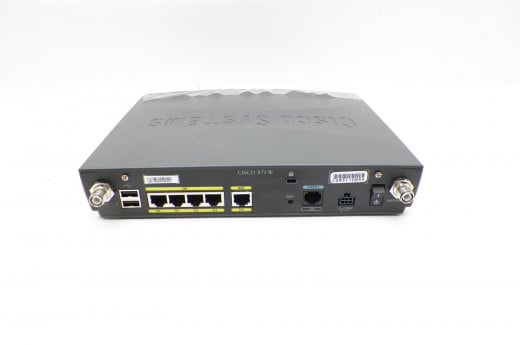
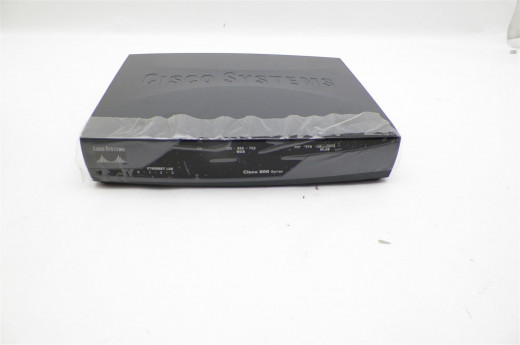
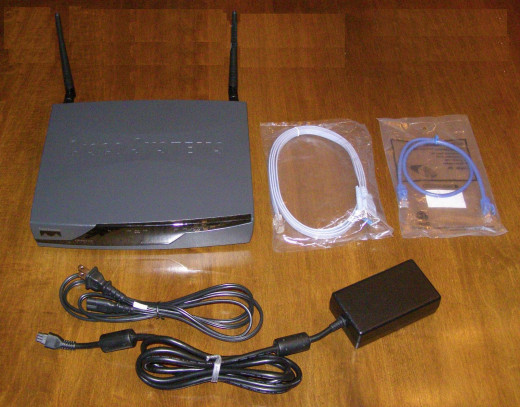
Let's look at some of this hardware, start with the: Cisco 871w
The Cisco 871w is an older, smaller and slower SOHO Wireless (the "w" in it's nomenclature) Router with only 4 switching ports and a true ability to be managed with pretty much full featured Cisco IOS capability. The one I ordered came with an upgrade to The Latest, Cisco IOS ver 15.
Why would I order a small old wireless router? You can do a LOT with it, that's why. At this point I am not so much concerned with performance as "administrative functionality". (for training purposes) in ICND1 or ICND2 level topics. Or, even for slightly more advanced configuration topics.
The 871w has:
- stateful packet inspection (FireWalling)
- 2 Wireless VLANS (10 max)
- 2 VLANS bridged to the 2 wireless LANS
- DSL PPoE client
- DHCP server
- 4-port VLAN capable switch configured to support 2 separate networks
You can perform all the basic required administrative tasks of routing on this little 871. You can configure basic forms of security, access control lists, you can even get a little funky and map sub-interfaces to VLANS, defining it on this router and creating bridged virtual interfaces to tie it all together. To do this you enable and specify the encryption for a specific wireless VLAN on the interface, then specify the authentication on the SSID. The VLAN and Bridged Virtual Interfaces (BVI's) are just to link the layer-2 wireless VLAN that you create together "bridging" the wireless VLAN to the Wired side, (with bridging commands and bridge groups) it's not the easiest basic configuration, and it's not like this hardware even does inter-vlan routing quickly... but it works. You can go on, and create sub-interfaces on the fast-ethernet port and use 802.1q trunking to have the multiple layer-2 VLANS tagged. .. IF you wanted to. But the point is. You could do an awful lot with this router. And it is old SOHO tech. But here, don't take MY word for it. Listen to Jeremy...
Jeremy Cioara on the 871w
Jeremy says ~
"Use the same old stuff, -'Do I have to go out and buy new equipment to run IOS 15?'- NO! You -do NOT! Just use the same old equipment. I don't mean to tangent off but, OSPF is still OSPF, PINGS are still PINGS, EIGRP is still EIGRP, and VLANS are still VLANS. So, like, the core of everything is still the same. IOS 15 is not like 'oh now you have to type the commands THIS way now'... it's the same commands, it's just with different licensing now.
So, I have this little router that I Love, and I recommended it in 2007, it's the Cisco 871w router. It's this little wireless do-jobber that you can pick up from eBay probably for less than 100 bucks. People still ask me, 'should I still use that little router?'
I would say... 'YEAH!' That router is AWESOME! It has a built-in switch, so you can do your VLANS on it, you can do your routing, NAT, and access-lists- ACCESS LISTS! That's something new on ICND1... uhm, you can do just a TON of stuff, so, How Much equipment should you buy? ...Well, if you could buy only ONE thing, I'd still say, 'buy that router', because it can do so much." [Jeremy Cioara]
I was fortunate to have a work environment with equipment
For years, everywhere I went, I had plenty of equipment and MORE than enough opportunity to work the basics out. In fact, I was kind of THRUST into it against my will, from time to time. Working for a V.A.R. can be tough. You're out on the road, going from client to client, you wind up at some site you've never seen before, and suddenly you are working with equipment you've never had a CLUE of before. But then, AFTER your day is over, all that sudden responsibility thrust upon you, you go, you read and study and THEN the light bulb comes on.
I was working for Symbol technologies building, testing and installing their spread-spectrum Radio-LAN hardware, for point of sale (POS) and warehousing applications. And, once again, you are thrust into environments you've never seen before. Sometimes you were suddenly an electrician and running cables, or logging into ancient versions of UNIX you've never even heard of... (and NEVER want to hear of ... Again).
And I must tell you, that I really did follow nobody's script in the equipment I selected and purchased to begin this lab-series, (Not even Jeremy's that I show here in this article.) But, if you wish to see a decent video on the "home lab" topic. I will (again) feature Jeremy Cioara, and use HIS "micro-nugget" that he referred to in the video clip above. And you will find a lot in common with the equipment I've picked thus far. But I probably picked it all for the SAME reasons Jeremy Did.
But wait... There's MORE...
After looking at MY choices, you WILL say to me, "why no big routers Steve?". Well, I DID get one Swouter, the C3550. It's a L3 Switch (meaning it routes packets as well as switches). And, I DO have that 871w. And, I have something else.
Something that will give me ALL The routers I will EVER need.
GNS3.
You'll see what I mean. GNS3 simulates and emulates routers within a computer. GNS3 is NOT "just" a simulation, sure, it simulates. Absolutely. But it also almost fully EMULATES Routers. What does that mean? What's the difference between simulation and emulation?
The difference between simulation and emulation.
Let's put it THIS way. If you are in a flight simulator, you SIMULATE flying. Maybe you even do a FULL simulation of flying. But... you do NOT actually "fly".
If you were in a flight EMULATOR... as you pulled levers, turned knobs, set vectors, and pushed the throttle forward, you'd be FLYING, in a full simulation that was also did the physical job OF flying! But you would be flying in something that is NOT "The Plane", that is being emulated. You'd TRAVEL from point A to point B. But it'd NOT be in an actual Boeing 777.
You'd be flying in something that EMULATED a 777, without BEING a 777.
That's what GNS3 does. No no no... NOT Flying! It almost fully emulates routers (inside a PC). It actually will route actual packets. But, GNS3 runs on a computer, within RAM, and emulates a routers functionality, and the circuitry. It simulates the serial cabling or the etherchannels you can make, and it even allows you to sample and analyze data-packet traffic inside those channels, with WireShark! The thing is this. If I wanted to setup a 2611XM router (as Jeremy suggests I should) I can do that on my rack mount server, (which has 2 gigabit ethernet ports built into it) And I can pipe IN packets in one eithernet port. into my emulated 2611XM router, and OUT the other ethernet interface...
And there, I've got my 2611XM router.
Except in my rack mount server... I can have a LOT MORE than just that one router. I can HAVE a 1700-series router, AND an 1800-series, AND a 3600 or 4700-series... I can connect different regions with switches also (within the GNS3). I can setup a whole network inside my PC and run a nearly fully emulated and complicated topology. GNS3 will even handle simulating switches to a limited degree. It switches at a basic level... it will handle VLANS and some trunking. Switches are harder to do. Their functionality is more demanding in a way that GNS3 does not handle so well. But the basics of switching are there.
Besides, That's what the "other" great emulator is for I.O.U. (IOS On Unix) - which also runs on an Intel (or AMD) CPU... but more on that later.
So, what do you think? Starting to sound interesting? Yeah, we can do a lot with a single PC and a couple of exterior switches. Or even one LITTLE Switching Router, (like the 871).
Jeremy Again - this is the "Micro-Nugget" he refers to above
Okay... so I did need SOME hardware to enable me to perform more extensive (and varied) labbing as I do get more deeply into Network Operations Development... So, I figured I'd start with something for a pesky PC that had no NIC in it, or if I wanted it to have two NIC's at the same time. Or, if a box had NO wireless NIC, and I needed a quick solution. Like, when running GNS3 under windows. So I get this Linksys AE2500. Yes, I know it says "Cisco" on the body of the USB stuck.
Many moons ago, I remember one of my favorite NIC Cards to use was Linksys. Cisco must've thought it was a good company too. They bought them to handle their SOHO needs.
I also got a "small" NIC for USB's The Cisco LinkSys AE2500
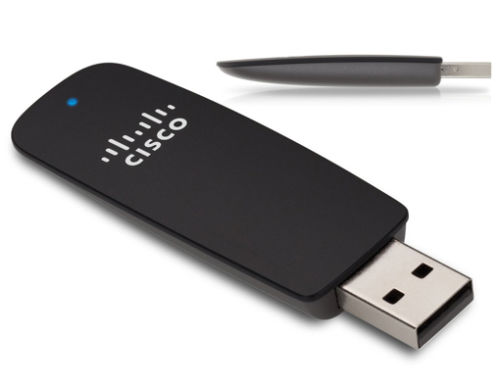
How can anybody have a network without Cisco 2950's
Ah, the venerable Cisco 2950. They are literally everywhere, some day I may build a carport using 2950's. Possibly pave a garden path with them... they are literally EVERY-Where! Inexpensive, highly dependable and functional. Just your standard good, basic switch. Later I will show you how to use GNS3 to do router (and basic switching) emulation. But because it is not possible to fully mimic switches in GNS3 you should buy a switch (or two). GNS3 can't replicate full switching function, because the application specific integrated circuits (ASIC's) that switches are based upon... are difficult to emulate. So, you really SHOULD have at least one, and possibly two switches in reality, on your bench. Which is part of the reason to start WITH the 871w. Now, if you just add a multiport (inexpensive) switch...
On one of the vmWare User groups (for Power CLI) one of the members was asking a question about vmWare NSX and "physical switches". He was configuring a home Lab, to do his NSX learning and was asking if the old C2900 switches were fine for it, or did VxLANS require different / newer hardware?
The general response was NO... the old switches are FINE for NSX, a packet is still just a Layer 2 (switched) data unit. And all that were required were standard VLANS. IF the topology were to start getting highly detailed with SOME kind of funky newfangled thing, it that MIGHT change. But packets are packets. The old hardware got blessings from the user group.
2950 Buy it NOW - on eBay - 20 bucks - plus or minus

You COULD buy both the 871w and a 2950 for about $100 total
I HAVE seen some of the less-pretty 871w's go for well under 100 dollars. Jeremy suggested you could get them "under" 100? Well, They are slightly more popular than that. And most new technicians are going to NEED and absolutely require a console cable, which is a roll-over cable, designed to go directly into a router or switches console port. So, I suspect you will more likely spend at least 90 or 100 dollars for an 871w.
New 871w's, out of the box, go for around 155 dollars.
But I HAVE seen them go for around 60 bucks, like, if they don't have a power supply. So, do be careful. you MUST have the power supply AND the antennae! You do NOT want to buy THAT power supply separately. So I got a roll-over and a patch cord, for the additional cash, along with a nice clean and freshly upgraded IOS, for $115. Not bad. But a tad more than Jeremy implied. I suggest YOU also just expect to get that little 871w at about 90 to 120 also.
But, it IS possible you could find the combo of a 2950 and an 871w for about 100 or 110 dollars, total. It's a worthy goal to try to obtain that price. I simply kept it in the ballpark but actually went up on the specifications for my 2950 a little.
I wanted some gigabit ethernet ports on my 2950.
I bumped it up a small notch to a sub species of 2950 that had 24 10/100 ethernet ports, and also 2 additional gigabit ethernet ports. See the picture below for a closeup of those ports. And, as you also see, the console port is on the back side of the switch, as it is with most similar models.
The Cisco WS-2950T-24 with (2X) 1000BaseT GB-ports - $35
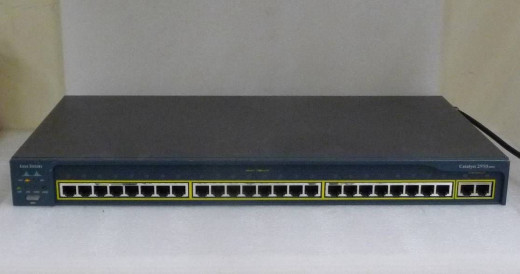

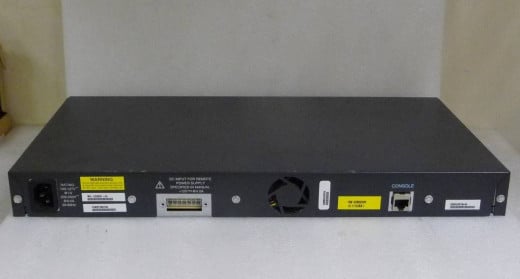
Then I wanted a Layer 3 switch: Cisco WS-C3550-48-EMI-L3
The Cisco 3550 series is considered to be Access-Layer hardware in the typical collapsed-core data center model. They are often found in the wiring closet of your department, or for the entire floor of a building. It is also considered a "Back-Bone" switch for mid-sized enterprises.
Okay, allow me to rephrase that. It IS Enterprise class... old school Enterprise Class for wired networks. Today's version of the C3550 would probably be more like the 3600 or 3800 series, which "CONVERGES" wireless networking and mobility within one box. So you don't require a separate wireless device. Which, back in 'the day' was the solution. And, the newer boxes with Cisco IOS15 are, of course going to also be much much faster technology. Instead of single digit Gigabits, we're talking multiples of GB per-pipe now. And also talking fiber to the desktop now...
You may have 10gb or 40gb or 100gb lines and channels on Cisco Boxes today. This (older) tech, tends to be 1GB per line. And 100mbps was considered "Fast" Ethernet.
But still, for learning purposes on a small lab... SAME CONCEPTS... As Jeremy was saying...
The Cisco 3550L3 combines routing ability, with a highly functional switch. A true, L3-Swtich. And, you are buying one for pennies on the dollar.
The Cisco 3550 I ordered comes with 2 special slots for what are known as GBIC Ethernet ports. The GBIC stands for GigaBit Interface Converter module, and is a separate purchase to enable the feature. (As in the case of the Cisco 4908 I mentioned earlier? The 4908G I purchased has 8 of the GBIC slots, all needing converter modules.) This particular WS3550L3 has 2 GBIC's for later trunking use. But, it does also have 48 of the regular, workhorse 10/100 Ethernet ports. It is a Cisco Catalyst WS3550-48-EMI L3 Switch.
What is EMI?
SMI, EMI, ~ Lions Tigers N Bears, Oh-My!
SMI - Standard Multi-layer Software Image ("but that would be SMSI..." -shut up-)
EMI - Enhanced Multi-layer Software Image ("but that-"... I said, SHUT IT!)
"What is the difference between SMI and EMI?" Well, isn't it OBVIOUS? One has an "S" and the other has an "E"... No? Not what you were expecting?
The REAL difference between SMI and EMI? Is MONEY. They represent different software control features associated with routing packets on the network, SMI comes with basic features, which still allow L3 routing within the switch, but if you want the bells and whistles you must pay for the upgrade. Cisco is (after all) a software company, and it obtains it's income by up-selling you on services. And it can only do that, if it offers limited versions of its software to you when you first purchase the basic hardware.
Translation: Once they set the hook, they then reel you in.
The original List Price of the WS3550-48 was $6,990 ... but you could Upgrade it from SMI to EMI if you wanted the enhanced routing. SMI supports basic unicast IP-routing via static routes and RIP ver 1 and 2. (And there is an expression we have in networking, "Friends do not let 'Friends' use RIP"... so there ya go...) EMI will give you advanced IP unicast and multicast routing such as OSPF- open shortest path first, IGRP- interior gateway routing protocol, EIGRP- enhanced interior gateway routing protocol, BGPv4- border gateway protocol ver 4, PIM- protocol independent multicast, and PBR- pabst blue-ribbon... sorry I meant to say "policy based routing".
Purchasing the Enhanced Multi-Layer support, enabled the Enterprise-class features including hardware-based IP unicast and multicast routing, and the Web Cache Communication Protocol (WCCP). There are more details on the differences between SMI and EMI, but it is all reachable on the Cisco website.
Yes, the above numbers mean I DID purchase this 3550 switch at 1/2 of one percent, of the original price (roughly).
Cisco Catalyst WS3550-48-EMI L3 w/(2X)GBIC
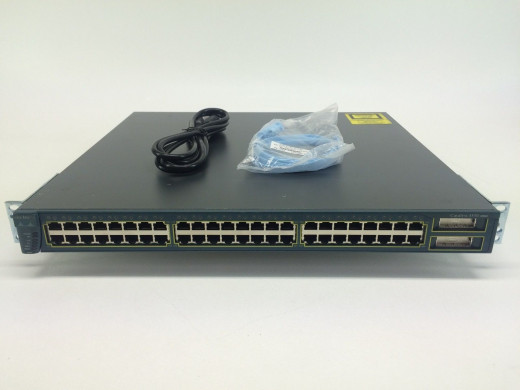
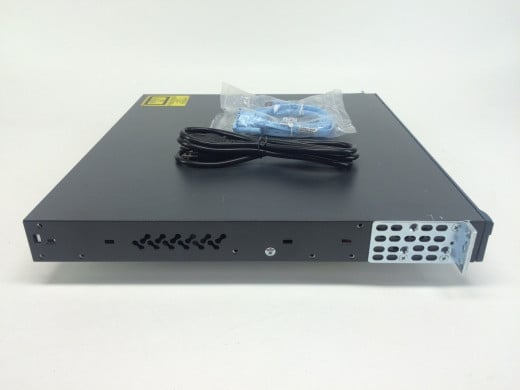
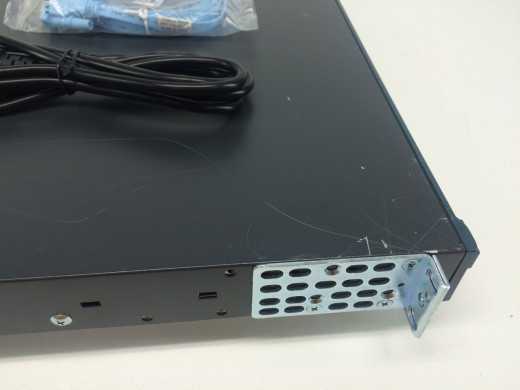
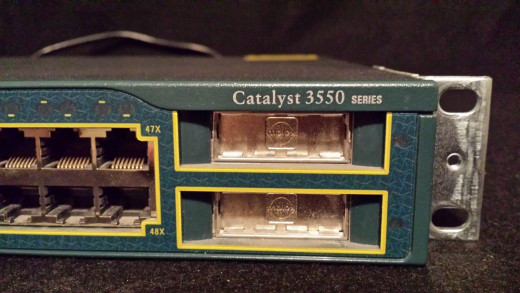
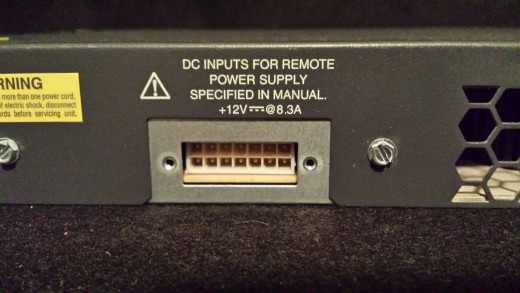
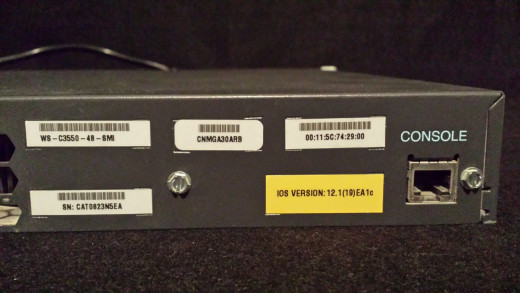
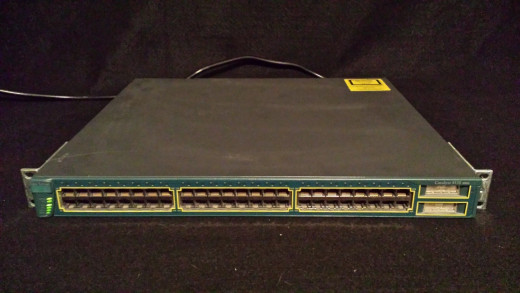
The Cisco 3800 vs The Cisco 3500 series
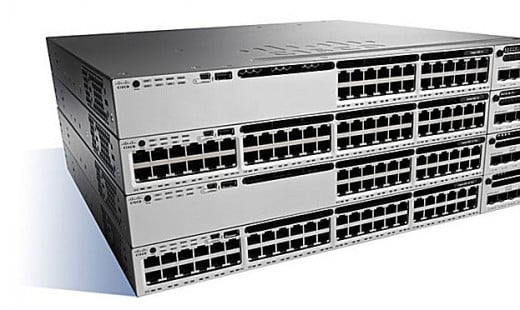
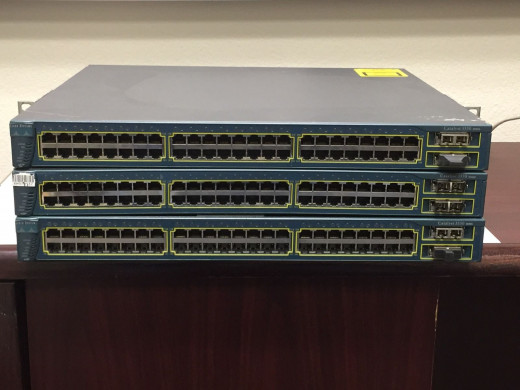
I realize it's not a REAL comparison to visually assess the hardware. But these ARE both "aggregation" switches.
Just from different hardware generations.
The 3800 series (top) is now re-labeled with the "hot" nomenclature of the day as a "convergence" series where wireless and wired networks - converge - inside the same box. This simplifies management (obviously) as your mobility, video, data OR voice is handled in one box now.
The 3550 is still excellent for training though. AND still useful for small business, if a small biz needs a "muscular" little wired switch like this.
GNS3 Cisco vmWare Network Lab Sim under a Laptop w/4GB
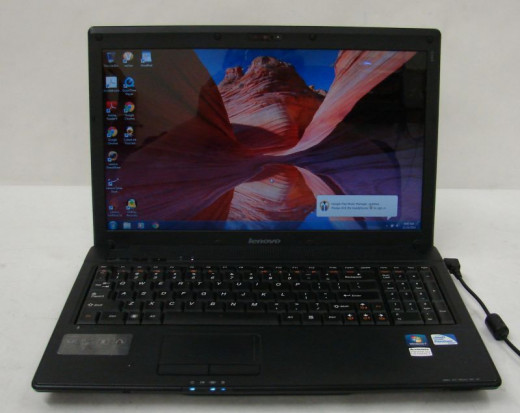
A Laptop, the 871w, vmWare and GNS3: Viola! a Net-Lab~!
My primary objective is actually fairly limited. Yet, the concept is powerful. Using a Lenovo (IBM) G560 Laptop with 4Gigs Ram. What I do want to do, is just prove the functional point of getting a good little (virtualized) network "Lab" up and running. Basically all emulated or simulated accurately enough within the RAM on that little laptop, to show that one can learn the greater majority of NOT JUST networking, but Data Center technology, right on that laptop. Learn enough and see enough to open the doors of basic functional understanding.
What do you think you could ACCURATELY simulate using vmWare Player, GNS3, and your Laptop? Did you know there are network topologies you can download for a GNS3 VM (Virtual Machine) and practice CCNA / CCNP Labs?
The only OTHER "required" piece of hardware will be the little Cisco 871w Router. And all that router is, is enough actual physical experience to (again) prove the point that, in order to do something one must assemble pieces, and configure the pieces enough via software and a little bit of cabling here and there, to make the Hodge-podge work. Whatever you "Hodge-podge" together.
At an absolute minimum everything can be "done" within RAM on the laptop. 4 gigs. And all else added on? Will be gravy. Good Learning. Good Labbing, and Good Tech. Each added additional physical piece will leverage UP the overall basic experience to resemble more and more accurately begin to resemble a "Real" networking / Data Center experience. And, of course, with the more appliances one has, whether virtual or real, the more configuring, functionality, additional software (like 3rd party vendors) and therefore, the MORE REAL.
But so much more can be had from commodity hardware, merely through Virtualizing the network.
IF "He Wins!" who dies with the MOST Hardware - - -
I'm going to need MORE Hardware. In fact.. I'm thinking- Now...
Down Immediately Below? We can see the 4908G L3 Switch I purchased. Now, "this" Switch, has 8 (GBIC) gigabit interfaces. And in each one of these slots pictured, you must plug in a Gibabit Interface Control Module, to give it an Etther-port.
So... ? As I build up components, I wonder in what ways these pieces will (eventually) be put into work? Stay tuned to find out.
Right now I've got that 2950T with two Gigabit Ether-ports. And, My 3550 has a couple of GBIC ports, but probably will NOT use those right away. And then there is the 4908 here, that is NOTHING but GBIC ports....
And
Catalyst 4908G L3 Hi Perf Sw - For Mid-sized Campus Backbones

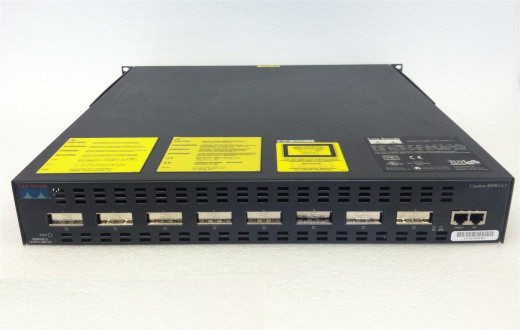
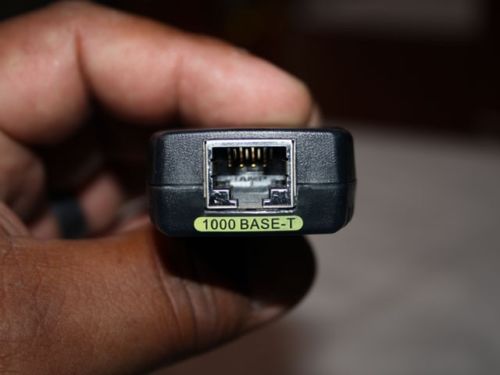
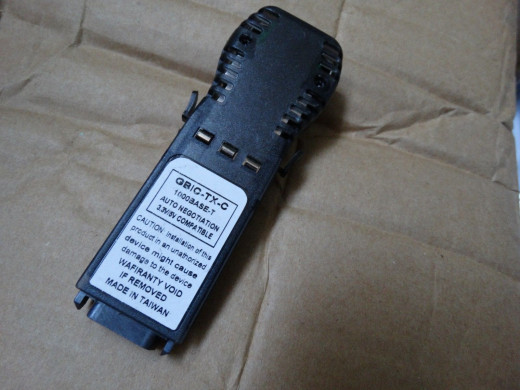
And then there is my Rack Server Dual-Quad CPU and 2TB HD
This server, likewise happens to have 2 GB Ether-ports built into it. And there are SO Many different ways this machine could be put into use, in Vurtualizing a Network.
2U Server Dual Quad Core Xeon CPU's w/32GB Ram - 2TB of HD

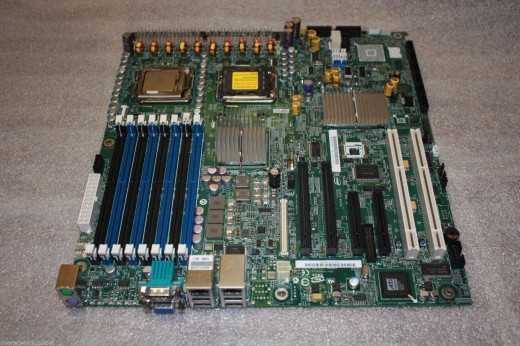
2U Server with Dual Quad-Core CPU and 2TB of Hard Disk
This machine I will use for my work and is a 2U Rackable Server with a Dual CPU (Quad-Core) Xeon Motherboard with 32GB of RAM and 2TB of hard disk storage. The machine also has (2X) 1000BaseT Ethernet Ports built into the Mobo.
Hmm, there's that (2X) GB ether-port idea again. And I've got this 2950T with dual GB ether-ports...
And I'll bet I can get QUITE a fully emulated network running within the RAM of that 8-core server... I wonder what performance I would get out of a full network emulation on that machine? I'll bet that if everything is "tweaked up" nicely, I could virtualize quite a LOT of devices. And, once virtualized, I will bet that there is a lot of automation, scripting and programming that can be implemented.
Good thing I downloaded vmWares PowerCLI (command line interface)
Looks like I could be busy for a while.

